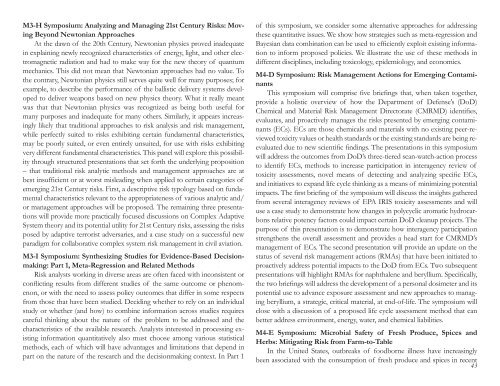Final Program - Society for Risk Analysis
Final Program - Society for Risk Analysis
Final Program - Society for Risk Analysis
You also want an ePaper? Increase the reach of your titles
YUMPU automatically turns print PDFs into web optimized ePapers that Google loves.
M3-H Symposium: Analyzing and Managing 21st Century <strong>Risk</strong>s: MovingBeyond Newtonian ApproachesAt the dawn of the 20th Century, Newtonian physics proved inadequatein explaining newly recognized characteristics of energy, light, and other electromagneticradiation and had to make way <strong>for</strong> the new theory of quantummechanics. This did not mean that Newtonian approaches had no value. Tothe contrary, Newtonian physics still serves quite well <strong>for</strong> many purposes; <strong>for</strong>example, to describe the per<strong>for</strong>mance of the ballistic delivery systems developedto deliver weapons based on new physics theory. What it really meantwas that that Newtonian physics was recognized as being both useful <strong>for</strong>many purposes and inadequate <strong>for</strong> many others. Similarly, it appears increasinglylikely that traditional approaches to risk analysis and risk management,while perfectly suited to risks exhibiting certain fundamental characteristics,may be poorly suited, or even entirely unsuited, <strong>for</strong> use with risks exhibitingvery different fundamental characteristics. This panel will explore this possibilitythrough structured presentations that set <strong>for</strong>th the underlying proposition– that traditional risk analytic methods and management approaches are atbest insufficient or at worst misleading when applied to certain categories ofemerging 21st Century risks. First, a descriptive risk typology based on fundamentalcharacteristics relevant to the appropriateness of various analytic and/or management approaches will be proposed. The remaining three presentationswill provide more practically focused discussions on Complex AdaptiveSystem theory and its potential utility <strong>for</strong> 21st Century risks, assessing the risksposed by adaptive terrorist adversaries, and a case study on a successful newparadigm <strong>for</strong> collaborative complex system risk management in civil aviation.M3-I Symposium: Synthesizing Studies <strong>for</strong> Evidence-Based Decisionmaking:Part 1, Meta-Regression and Related Methods<strong>Risk</strong> analysts working in diverse areas are often faced with inconsistent orconflicting results from different studies of the same outcome or phenomenon,or with the need to assess policy outcomes that differ in some respectsfrom those that have been studied. Deciding whether to rely on an individualstudy or whether (and how) to combine in<strong>for</strong>mation across studies requirescareful thinking about the nature of the problem to be addressed and thecharacteristics of the available research. Analysts interested in processing existingin<strong>for</strong>mation quantitatively also must choose among various statisticalmethods, each of which will have advantages and limitations that depend inpart on the nature of the research and the decisionmaking context. In Part 1of this symposium, we consider some alternative approaches <strong>for</strong> addressingthese quantitative issues. We show how strategies such as meta-regression andBayesian data combination can be used to efficiently exploit existing in<strong>for</strong>mationto in<strong>for</strong>m proposed policies. We illustrate the use of these methods indifferent disciplines, including toxicology, epidemiology, and economics.M4-D Symposium: <strong>Risk</strong> Management Actions <strong>for</strong> Emerging ContaminantsThis symposium will comprise five briefings that, when taken together,provide a holistic overview of how the Department of Defense’s (DoD)Chemical and Material <strong>Risk</strong> Management Directorate (CMRMD) identifies,evaluates, and proactively manages the risks presented by emerging contaminants(ECs). ECs are those chemicals and materials with no existing peer-reviewedtoxicity values or health standards or the existing standards are being reevaluateddue to new scientific findings. The presentations in this symposiumwill address the outcomes from DoD’s three-tiered scan-watch-action processto identify ECs, methods to increase participation in interagency review oftoxicity assessments, novel means of detecting and analyzing specific ECs,and initiatives to expand life cycle thinking as a means of minimizing potentialimpacts. The first briefing of the symposium will discuss the insights gatheredfrom several interagency reviews of EPA IRIS toxicity assessments and willuse a case study to demonstrate how changes in polycyclic aromatic hydrocarbonsrelative potency factors could impact certain DoD cleanup projects. Thepurpose of this presentation is to demonstrate how interagency participationstrengthens the overall assessment and provides a head start <strong>for</strong> CMRMD’smanagement of ECs. The second presentation will provide an update on thestatus of several risk management actions (RMAs) that have been initiated toproactively address potential impacts to the DoD from ECs. Two subsequentpresentations will highlight RMAs <strong>for</strong> naphthalene and beryllium. Specifically,the two briefings will address the development of a personal dosimeter and itspotential use to advance exposure assessment and new approaches to managingberyllium, a strategic, critical material, at end-of-life. The symposium willclose with a discussion of a proposed life cycle assessment method that canbetter address environment, energy, water, and chemical liabilities.M4-E Symposium: Microbial Safety of Fresh Produce, Spices andHerbs: Mitigating <strong>Risk</strong> from Farm-to-TableIn the United States, outbreaks of foodborne illness have increasinglybeen associated with the consumption of fresh produce and spices in recent43
















